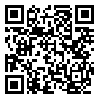Volume 77, Issue 1 (April 2019)
Tehran Univ Med J 2019, 77(1): 26-32 |
Back to browse issues page
Download citation:
BibTeX | RIS | EndNote | Medlars | ProCite | Reference Manager | RefWorks
Send citation to:



BibTeX | RIS | EndNote | Medlars | ProCite | Reference Manager | RefWorks
Send citation to:
Ghorbani-Anarkooli M, Dabirian S, Moladoust H, Zendedel A, Bahadori M H. Comparison of MTT, trypan blue, and clonogenic assay, to determine the viability in human anaplastic thyroid cancer cell line. Tehran Univ Med J 2019; 77 (1) :26-32
URL: http://tumj.tums.ac.ir/article-1-9559-en.html
URL: http://tumj.tums.ac.ir/article-1-9559-en.html
Marjan Ghorbani-Anarkooli1 
 , Sara Dabirian2
, Sara Dabirian2 
 , Hasan Moladoust3
, Hasan Moladoust3 
 , Adib Zendedel1
, Adib Zendedel1 
 , Mohammad Hadi Bahadori *
, Mohammad Hadi Bahadori * 
 4
4

 , Sara Dabirian2
, Sara Dabirian2 
 , Hasan Moladoust3
, Hasan Moladoust3 
 , Adib Zendedel1
, Adib Zendedel1 
 , Mohammad Hadi Bahadori *
, Mohammad Hadi Bahadori * 
 4
4
1- Department of Anatomical Sciences, School of Medicine, Guilan University of Medical Sciences, Rasht, Iran.
2- Department of Pharmaceutical Biotechnology, School of Pharmacy, Guilan University of Medical Sciences, Rasht, Iran.
3- Department of Biochemistry and Medical Physics, School of Medicine, Guilan University of Medical Sciences, Rasht, Iran.
4- Cellular and Molecular Research Center, School of Medicine, Guilan University of Medical Sciences, Rasht, Iran. ,bahadori.mh@gmail.com
2- Department of Pharmaceutical Biotechnology, School of Pharmacy, Guilan University of Medical Sciences, Rasht, Iran.
3- Department of Biochemistry and Medical Physics, School of Medicine, Guilan University of Medical Sciences, Rasht, Iran.
4- Cellular and Molecular Research Center, School of Medicine, Guilan University of Medical Sciences, Rasht, Iran. ,
Abstract: (4961 Views)
Background: Evaluation of cell viability is momentous in pharmacologic and oncological research. Cell viability evaluation determines cell sensitivity and consequently treatment outcome. Various methods are available to determine cell survival. Each of these methods evaluates different endpoints. Accordingly, determining the correlation between these methods is important. In this study, in order to determine the viability of human anaplastic thyroid cancer cell line, the sensitivity of MTT [3-(4,5-dimethylthiazol-2-yl)-2,5-diphenyltetrazolium bromide] assay, trypan blue test and clonogenic assay were compared.
Methods: This experimental study was performed in the Cellular and Molecular Research Center at Guilan University of Medical Sciences, Rasht, Iran from October 2016 to March 2017. The human anaplastic thyroid cancer cell line was cultured in Dulbecco's modified Eagle's medium (DMEM) with 10% fetal bovine serum (FBS). The cultured cells were treated with melatonin, for 24 hours. Then, the viability of the cells was evaluated by MTT assay, trypan blue test and clonogenic assay. Furthermore, plating efficiency and surviving fraction were used in order to draw survival curve in the clonogenic assay.
Results: The concentration of melatonin at IC50 point was 4.794±0.117 millimolar (mM) in MTT assay, 4.375±0.894 mM in trypan blue test and 2.246±0.326 mM in clonogenic assay. Comparing the IC50 values of these test revealed that C50 values obtained from MTT assay and trypan blue test had no significant difference (P=0.6446), while there was a significant difference between IC50 values obtained from MTT and clonogenic assays (P=0.0032). Moreover, the IC50 values obtained from trypan blue test and clonogenic assay were also significantly different (P=0.0078). The results of the regression analysis of cell viability were shown a linear, positive and significant correlation between these three methods and MTT assay and trypan blue test showed higher correlation (r=0.99, P<0.001).
Conclusion: Based on our results, all these methods were effective to identify cytotoxicity in human anaplastic thyroid cancer cell line, while MTT assay and trypan blue test were more sensitive than clonogenic assay.
Methods: This experimental study was performed in the Cellular and Molecular Research Center at Guilan University of Medical Sciences, Rasht, Iran from October 2016 to March 2017. The human anaplastic thyroid cancer cell line was cultured in Dulbecco's modified Eagle's medium (DMEM) with 10% fetal bovine serum (FBS). The cultured cells were treated with melatonin, for 24 hours. Then, the viability of the cells was evaluated by MTT assay, trypan blue test and clonogenic assay. Furthermore, plating efficiency and surviving fraction were used in order to draw survival curve in the clonogenic assay.
Results: The concentration of melatonin at IC50 point was 4.794±0.117 millimolar (mM) in MTT assay, 4.375±0.894 mM in trypan blue test and 2.246±0.326 mM in clonogenic assay. Comparing the IC50 values of these test revealed that C50 values obtained from MTT assay and trypan blue test had no significant difference (P=0.6446), while there was a significant difference between IC50 values obtained from MTT and clonogenic assays (P=0.0032). Moreover, the IC50 values obtained from trypan blue test and clonogenic assay were also significantly different (P=0.0078). The results of the regression analysis of cell viability were shown a linear, positive and significant correlation between these three methods and MTT assay and trypan blue test showed higher correlation (r=0.99, P<0.001).
Conclusion: Based on our results, all these methods were effective to identify cytotoxicity in human anaplastic thyroid cancer cell line, while MTT assay and trypan blue test were more sensitive than clonogenic assay.
Keywords: cell survival, colony-forming units assay, melatonin, MTT formazan, thyroid carcinoma, trypan blue
Type of Study: Original Article |
Send email to the article author
| Rights and permissions | |
 |
This work is licensed under a Creative Commons Attribution-NonCommercial 4.0 International License. |



